
MINISTRY OF EDUCATION
AND TRAINING
VIETNAM ACADEMY OF
SCIENCE AND TECHNOLOGY
GRADUATED UNIVERSITY
OF SCIENCE AND TECHNOLOGY
-----------------------------
Dang Hong Luu
INVESTIGATION OF METAMATERIAL ABSORBER
IN THE THz REGION
MAJOR: ELECTRONIC MATERIALS
NUMBER: 9440123
THESIS ABSTRACT
Hanoi - 2018

This thesis was studied in: Graduated University of Science
and Technology, Vietnam Academy of Science and
Technology.
Supervisor: 1. Assoc. Prof. Vu Dinh Lam
2. Dr. Le Dac Tuyen
Peer review 1:
Peer review 2:
Peer review 3:
This thesis will be defended at the Graduated University of
Science and Technology - Vietnam Academy of Science and
Technology, ……h/ ……/……./2019
This thesis will be saved in:
- Library of Graduated University of Science and Technology
- Vietnam National Library

1
INTRODUCTION
1. Necessaries of thesis
Metamaterial (MM) is artificial structure having
extraordinary electromagnetic features not found in nature.
Structure of MM is designed with meta-atoms, which interacts
with both the electric and magnetic fields of the electromagnetic
wave. Therefore, MM can create many interesting properties.
Nowday, some properties of MM were demonstrated in both
theorical and experimental experiments by many research groups
independently. However, novel properties of MM are discovered
and significantly affect to science and physics.
Many significant studies are focus mostly in negative
refractive index metamaterial (NRM), metamaterial absorber
(MA), or a combination of those in particular applications. MA
is able to absorb unity electromagnetic wave with geometric
scale much smaller than operating wavelength. In Vietnam,
research on metamaterials is mostly GHz region according to
limitations of fabrication and measurement.
In Terahertz (THz) region, an interaction between
electromagnetic wave with metamaterial in micrometer and
nanometer scale is much complicated because of quantum effects.
Beside, THz technology is appying in many fields: military,
information technology, media, biology, medicine, security,
environment, etc. Therefore, MM operating in THz region is
gaining much attention of researchers in worldwide, with many
significant applications in Laser in THz region, scanning system,
national defence. Otherwise, it is a fundamental field for
investigating metamaterial in visible region. With these reasons,

2
studying metamaterial in THz region is extremely significant.
2. Purposes of the thesis
- Propose physical mechanism to investigate metamaterial
absorber operating in THz region.
- Design, simulation, and characterizations of MA in THz
region. Optimize parameter structure to increase absorption
and broaden operating wavelength region, modify operating
wavelength by external factors.
- Fabricate MA operating in THz region. Study
electromagnetic properties and applications.
3. Main research
- Investigate MAs operating in THz region.
- Simplify MA structures, which will be available for
fabrication in THz region with broadband and tunable by
external factors.
- Study on applications of MAs.
Accomplishment: This thesis proposed MA structure operating
in THz region: 1) Optimize MA structure to improve absorption
and broaden operating wavelengths; 2) Propose MA model
controlling absorbing properties by optical pumping and
temperature in THz region; 3) Demonstrate ability of MA to
enhance oscillating signal of molecules and applied to sensitively
detect Bovine Serum Albumin.
This thesis consists
Chapter 1: Introduction
Chapter 2: Research method
Chapter 3: Optimization for MA structures

3
Chapter 4: Controlling the operating wavelength of MAs
and applying it for sensor
Chapter 5: MA based on near-field coupling and Babinet
effects.
CHAPTER 1: INTRODUCTION
1.1 Introduction to metamaterial
Metamaterial (MM) is artificial material constructed by
meta-atom in particular arrangement, similar to unit-cell in
crystal lattice of conventional materials. The scale of meta-atom
is much smaller than operating wavelength. In several recent
years, researchs on metamaterial developes considerably, related
to other scientific fields as fundamential physics, optics, material
science, electronic engineering, etc.
1.2. Classification of MM
Fig. 1.3. Classification of MMs based on permittivity and
permeability
1.3. Effective medium theory
According to effective medium theory (EMT), one could
consider MM as homogenous medium with effective permittivity

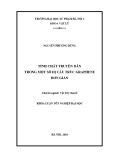

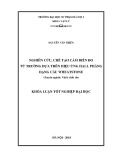
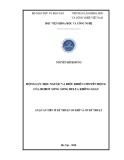
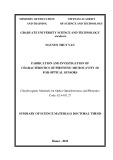
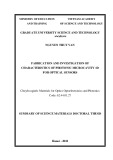
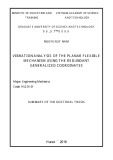
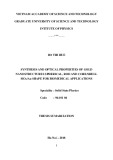
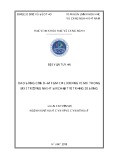
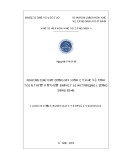

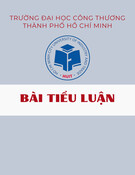
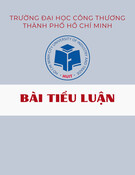
![Ô nhiễm môi trường không khí: Bài tiểu luận [Nổi bật/Chi tiết/Phân tích]](https://cdn.tailieu.vn/images/document/thumbnail/2025/20251011/kimphuong1001/135x160/76241760173495.jpg)







![Ứng dụng kỹ thuật trao đổi ion trong điện phân: Bài tiểu luận [chuẩn nhất]](https://cdn.tailieu.vn/images/document/thumbnail/2025/20250829/sonphamxuan1808/135x160/97341756442892.jpg)



